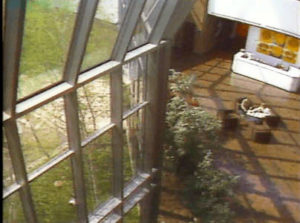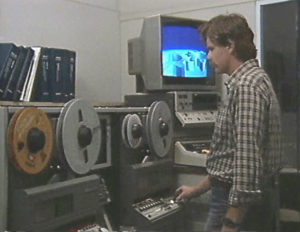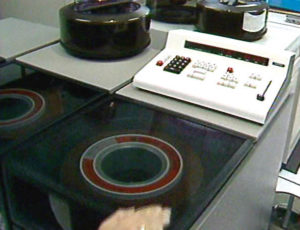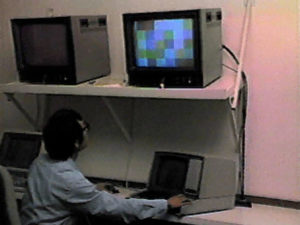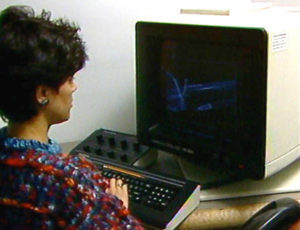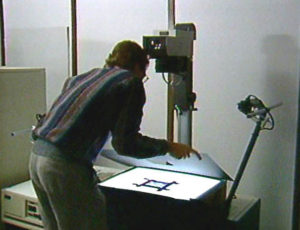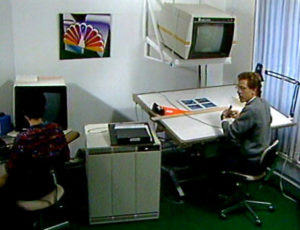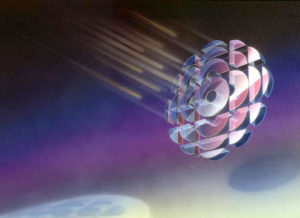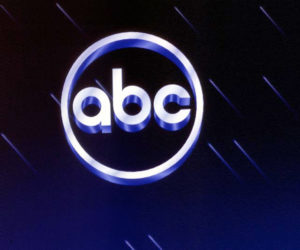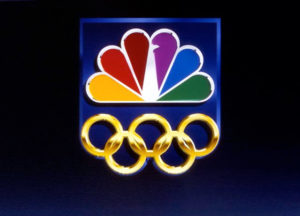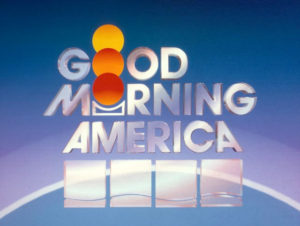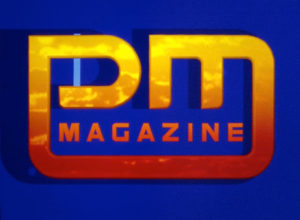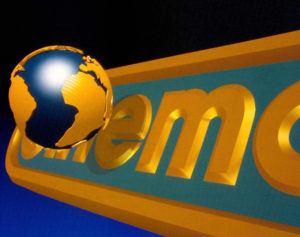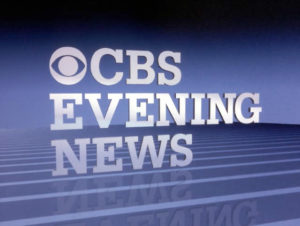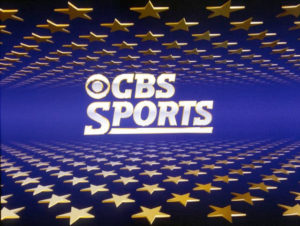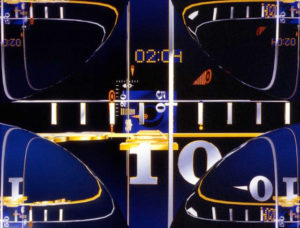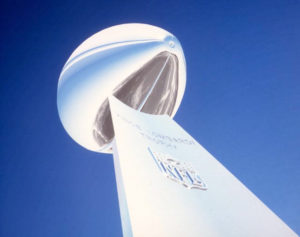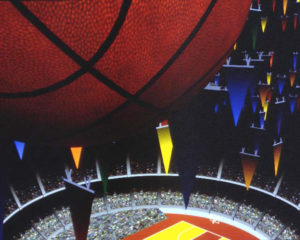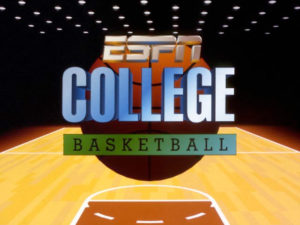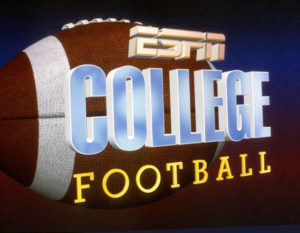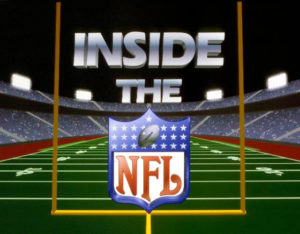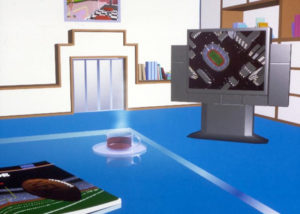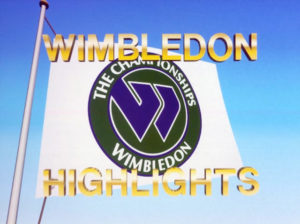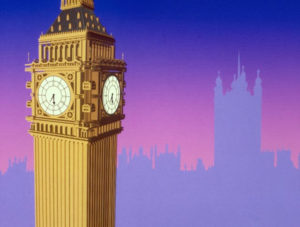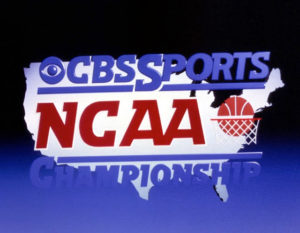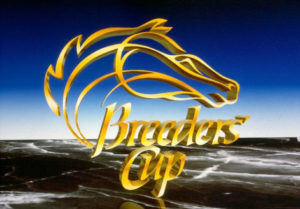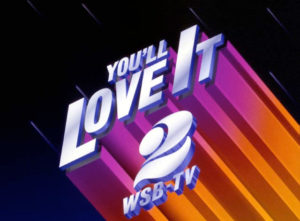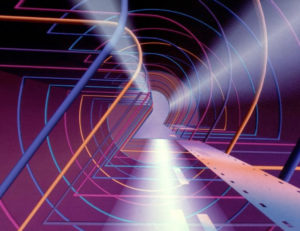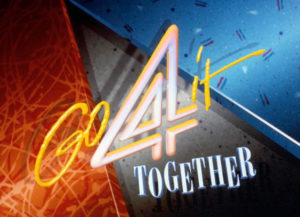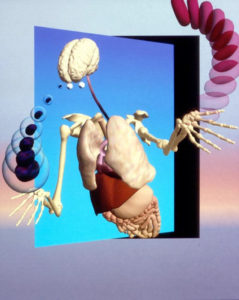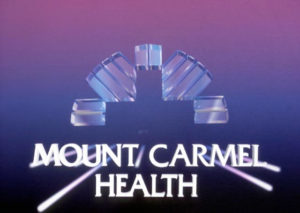Chapter 6: Commercial Companies
6.6 Cranston/Csuri Productions

In 1981, Charles Csuri approached an investor (Robert Kanuth of The Cranston Companies) to transfer the computer animation technology created in the CGRG lab at Ohio State to the commercial world, and Cranston/Csuri Productions, Inc. (C/CP) was formed.
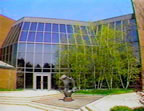
It moved, along with CGRG to a Columbus facility, the former Academy for Contemporary Problems building, at 1501 Neil Avenue in Columbus. This co-location of the two organizations was important to the continuing development of each. Kanuth appointed one of his officers at The Cranston Companies, Jim Kristoff, as President of C/CP, and he recruited six of the CGRG researchers to join the company as a core group.
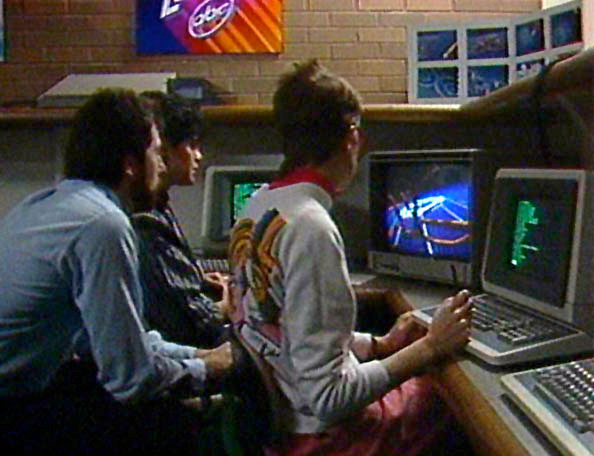
These six C/CP staff (Michael Collery, Wayne Carlson, Bob Marshall, Don Stredney, Ed Tripp, and Marc Howard) rewrote the software that was in the research lab so that it was more user-friendly and less research oriented, and added specialized utilities for character animation, procedural effects, rendering, geometric modeling and post production. They also expanded the capabilities of the hardware, including their proprietary frame buffers to provide tools for the growing animation staff.
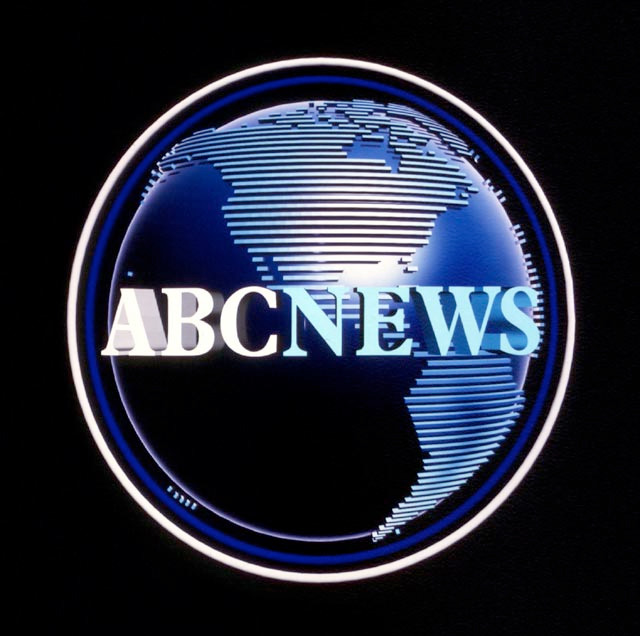
The suite of software was used to produce animation for television and advertising until C/CP went out of business in late 1987. During the tech transfer first year, Carlson reworked the modeling program DG, Julian Gomez rewrote the animation language Twixt for use at C/CP, and Stredney and Collery produced a sequence of animations that were edited together into a preliminary demonstration reel to take to potential clients. One of the first major clients was ABC News – C/CP was contracted to produce promotional graphics and openings for all 11 of the network news programs.
The strengths of C/CP were high quality image making hardware and software that was focused on the limited markets they chose to serve (television broadcast and promotion, advertising, and medical documentaries.) Production included a market-appropriate direct-to-video solution that made the production process very efficient. Exceptional sales efforts started with Kristoff and Mark Del Col, and later Scott Haines from Disney and Dobbie Schiff. They also had an effective design staff, headed by Paul Sidlo (Rezn8), that included Steve Martino, John Weber, Ronnie Chang and others.
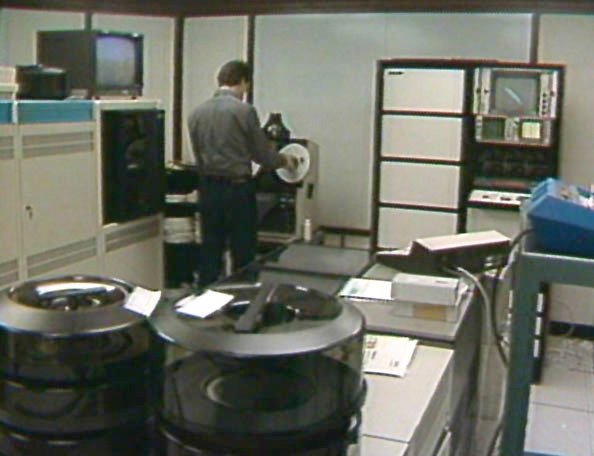
Special purpose hardware included the Marc III and Marc IV custom frame buffers, which were designed and built by C/CP employee Marc Howard. These frame buffers provided the ability to do extended low resolution pre-visualization motion tests that were stored in frame buffer memory and played back in real time. C/CP used Vax 11/750s, 11/780s, Pyramid computers, Sun workstations, Megatek, IMI and E&S Picture Systems vector displays, and a modified Ampex Electronic Still Store (ESS), which was originally designed for slow motion replay by the television network sports industry[1]. Images were calculated and stored on one of several magnetic disks; the machine was programmable to facilitate the 30fps playback with a direct NTSC video output. C/CP also had a Celco 4000 film recorder, which could be used for 16mm, 35mm and 70mm motion picture film, or 35mm slide or 4×5 transparency still output.
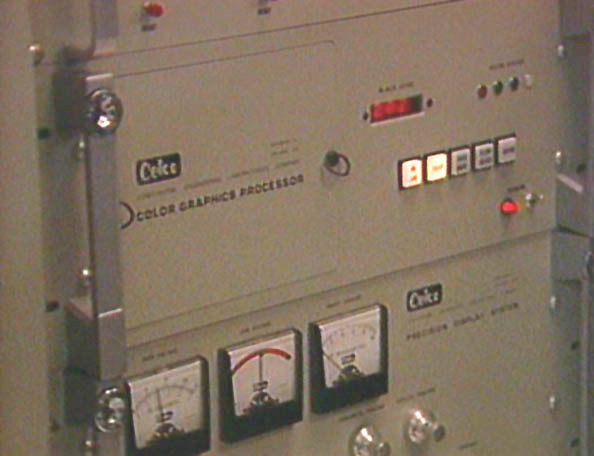
During the seven year period that they were in business, C/CP produced almost 800 animation projects for over 400 clients world-wide. A long-standing relationship with Roger Goodman of ABC resulted in continuous contracts for the production of graphics for ABC Sports for many years.
Key projects included: opening graphics for 3 Super Bowls; the on-air sports promotions for ABC, CBS, NBC, and ESPN networks; news opens and promos for all of ABC’s news shows, as well as news opens for CBS, CBN, Fox and PBS; international network promos for ARD (Germany) CBC (Canada) ABC (Australia), Globo (Brazil) and Scottish Television; entertainment graphics for ABC, NBC, CBS, Turner, Showtime, HBO, Fox, and over 100 local affiliates; award winning ads for TRW, Sony, Proctor and Gamble, AEP, G.E., and Dow; music videos for Krokus, Twisted Sister and Chaka Khan; special projects for Goldcrest Films (The Body Machine), CoMap and the Annenberg Foundation (VISUmap animations for “For All Practical Purposes” mathematics telecourse.)
During this period, C/CP staff continued to extend the research boundaries and publish new and innovative results. Former staff members included Shaun Ho (SGI), Michael Collery (PDI), Scott Dyer (Nelvana), Jeff Light (ILM), John Berton (ILM), Susan Van Baerle (Windlight), Maria Palazzi (ACCAD), Doug Kingsbury (Lamb and Co.), John Donkin (Blue Sky), Peter Carswell (OSC), Paul Sidlo (RezN8), Jim Kristoff and Dobbie Schiff (Metrolight), Rick McKee (SGI), Jean Cunningham (PDI), John Townley and Steve Martino (click3west), Tom Longtin and many others.
In 1985 C/CP licensed their production software to Japan Computer Graphics Laboratory (JCGL) for use in the Japanese market. JCGL’s president was Japanese businessman Mitsuro (Mits) Kaneko, who later became friends with Jim Kristoff.
The relationship between Kristoff and the board of C/CP cooled in late 1986 and early 1987, primarily because of Kristoff’s position that an office needed to be opened in L.A. that would allow C/CP to expand into other markets. In fact, a number of former Abel employees, including Tim McGovern, Con Pederson, Neil Eskuri and “Doc” Baily, were hired and relocated to Columbus for training, ostensibly to prepare to staff an L.A. office. Kaneko and Kristoff proposed an investment strategy that would increase their control, but the funding was not available. Kristoff resigned, and later opened Metrolight (originally to be called Northern Lights Productions) in L.A. and Wayne Carlson was named President, as Chuck Csuri had left C/CP in 1985 to return to his OSU duties at CGRG. Carlson saw the company through Chapter 11 liquidation (the software was purchased by Lamb and Company in Minneapolis), and Cranston/Csuri formally closed in October, 1987.
Movie 6.25 Gears – NCGA Demo
Created by Tom Longtin
Movie 6.26 C/CP Demo (1982)
http://www.youtube.com/watch?v=ghNjMCHyu5w
Movie 6.27 C/CP Demo (1983)
http://www.youtube.com/watch?v=6EOFjHbiVMY
Movie 6.28 C/CP Demo (1985)
http://www.youtube.com/watch?v=Q8TYobTi234
Movie 6.29 Clio Finalist Ad for TRW (1986)
http://www.youtube.com/watch?v=GvICw-8WaGk
Movie 6.30 C/CP Ads Reel
http://www.youtube.com/watch?v=8CVkBZJ_zpI
Cranston/Csuri Productions produced over 800 animations for over 400 clients worldwide. Every major television network, including ABC, CBS, NBC, the Canadian Broadcasting Co., German ARD Television, ABC Australia, Rede Globo in Brazil, and the BBC had show openings or promotions produced at
C/CP.
Cable networks, including HBO, Cinemax, The Turner Broadcasting Network, TNN, the Country Music Channel, CNN and others did the same.
Sports broadcasts were a specialty, and C/CP produced graphics and animation for CBS Sports, ABC Sports, NBC Sports, ESPN, the NFL, NFL Films, HBO and others. C/CP produced the opening for two Super Bowls, the NCAA Basketball Championships, Major League Baseball, the Breeder’s Cup, Wimbledon, College Football and Basketball, and IROC Racing.
All of the major news shows used C/CP graphics, including NBC Nightly News, ABC World News Tonight, and CBS Evening News. ABC contracted for all 11 of their major news shows, and also for the United Airlines in-flight broadcast.
Advertisements included Clio nominated TRW pieces, ads for Sony, IBM, Ameritech, McDonnel Douglas, Jeep, Contac Cold Capsules, Actifed, General Electric, Pert Plus, Procter and Gamble, Always overnight pads, M&I Banks, Benjamin Moore Paints, Lowenbrau Beer, Warner Cable, and many others.
Corporate communications were done for GE, IBM, American Electric Power, Mount Carmel Health, Landor and Associates, Cranston Securities, Cranston Development, and others.
C/CP also specialized in medical animation, producing dozens of sequences for the BBC series The Body Machine. They produced over 40 segments for the Annenberg series on Mathematics for PBS. The produced a generic promotional package for local television markets, customizing it for almost 100 local stations.
They did scene tests for several motion pictures, including an unnamed movie from Disney, Flight of the Navigator,and the Brave Little Toaster.
For a complete list of the C/CP clients, go to https://ohiostate.pressbooks.pub/app/uploads/sites/45/2020/01/CCPClients.pdf
Gallery 6.4 Cranston/Csuri Productions Image Collection
- Interior lobby of the Cranston/Csuri headquarters in Columbus
- Bob Lyon editing on the Ampex 1” recorders.
- The CCP Ampex Electronic Still Store (ESS)
- Hsuen Chung Ho working on the video playback software.
- Maria Palazzi at the IMI500 Display
- Steve Martino at the film capture station.
- Steve Martino at the digitizing table with the Megatek display
- Drawing for design of Canadian Broadcasting (produced by Bo Gehring)
- ABC Fall promotion
- NBC Fall Campaign
- NBC Winter Olympics Show promotional graphics
- Good Morning America Show Open
- PM Magazine show open
- Cinemax show open
- CBS Evening News Show Open
- CBS Sports NFL promotion
- Superbowl opening graphics
- Lombardi Trophy – part of NFL SuperBowl promotion
- ESPN College Basketball show open
- ESPN College Basketball show open
- ESPN College Football show open
- Inside the NFL show open
- Inside the NFL promotional graphics
- Wimbledon tournament graphics
- Wimbledon tournament highlights promotion
- CBS Final Four animation
- NBC Breeders Cup promotional graphics
- ABC affiliates promotional graphics
- ABC affiliates promotional graphics – Channel 2 in New York
- Channel 4 Detroit graphics
- The Body Machine graphics
- Originally introduced in 1977 for use by CBS Sports, Ampex was awarded an Emmy for the technology. An article from the SMPTE Journal stated: "The preparation, storage, retrieval, and broadcasting of stills (slides and graphics) add up to a significant cost element that must be controlled in the operation of a typical television facility. The physical handling in using stills can damage the materials and result in human error. Furthermore, reserving a studio camera and/or a telecine chain to show stills is inefficient and not cost-effective. A new system to overcome these problems, the Electronic Still Store (ESS), has now been demonstrated by CBS and Ampex. The ESS can randomly search an electronic library of still pictures from a number of locations, arrange the stills in the order for playing, play them as fast as 1 still/s, and do these things without physically touching the media. The system makes available a current stock of about 1500 stills (those expected to be needed within the next 100 days) and a long-term stock of about 5000 stills. System control tasks are handled by an LSI-11 microcomputer which emulates the larger PDP-11/40. The core element of the ESS is a very reliable computer disc drive. The adaptation of the disc drive for storing PCM video requires only that the dissimilar standards of digitally encoded video and the computer peripheral be reconciled." Published in: SMPTE Journal ( Volume: 85, Issue: 8, Aug. 1976 ) ↵
